13 Carbon, Energy, Metabolism
This chapter is a near–final draft. Some glossary entries need to be added.
Learning Outcomes
By the end of this section you should be able to:
- Describe and classify carbon atoms into isotopes and carbon compounds into oxidized and reduced categories
- Account for the flow of energy during photosynthesis and respiration reactions
- Trace the flow of carbon through the carbon cycle in the main spheres of the Earth
All life on Earth is built from carbon compounds, and reactions involving carbon are critical to the energy balance of the Biosphere. In this section we look at the structure of carbon atoms and then look at the fundamental reactions – photosynthesis and respiration – that allow energy to be trapped and the released by the Biosphere.
Carbon
Carbon atoms
Carbon, atomic symbol C, is element number 6 in the periodic table, which means that all atoms have 6 protons in the nucleus. In addition, there are six neutrons, usually, giving carbon an atomic weight of about 12.

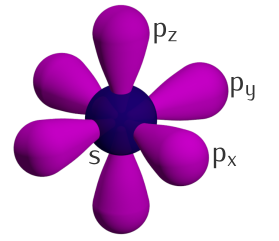
![]()
Why do we say “usually”? There are other isotopes of carbon that have different numbers of neutrons in the nucleus. Carbon-13 has 7 neutrons, while Carbon-14 has eight. Carbon 13 is a stable isotope which makes up just over 1% of most naturally occurring carbon. This percentage varies slightly . For example, if carbon dioxide is released into the atmosphere from water, any molecules containing carbon-13 are a little heavier, and therefore tend to evaporate a little more slowly. Measurements of proportion of carbon-13 are sometimes useful in tracking carbon through the carbon cycle.
Carbon-14 is an unstable isotope. This means that atoms of carbon-14 have a tendency to break down over time. Carbon-14 atoms decay by emitting a beta particle (actually a high-speed electron) from the nucleus, changing a neutron into a proton and creating an atom of nitrogen (element 7). This process is a random, statistical process, so that in a given mass of carbon-14, about half of the atoms will break down in 5730 (± 40) years. This allows carbon-14 to be used for isotopic dating. The action of cosmic radiation nitrogen in the upper troposphere and lower stratosphere keeps the proportion of carbon-14 approximately constant at 1.35 x 10-12, or a little over one atom per trillion.
For chemical reactions, only the electrons are important. Like all elements, carbon has the same number of electrons as protons, in this case 6. These electrons are organized in two electron shells, an inner one that is full at two electrons, and an outer shell that is half-full with the remaining four electrons. The four electrons and four vacancies in its outer shell allow carbon to form an astounding variety of chemical compounds in which electrons are shared in covalent bonds with other atoms. These atoms can include other carbon atoms, atoms of oxygen (O) and hydrogen (H), nitrogen (N), phosphorus (P), and many other elements. This is the chemical basis of life. Bonds with other carbon atoms, and with oxygen and hydrogen are particularly important in the energy cycle.
Carbon bonds
Carbon dioxide is a gas in which the four outer electrons of carbon are shared with two oxygen atoms, which each contribute two electrons the merged electron shells. The bonds between carbon and oxygen are known as double bonds, represented C=O. A large amount of energy is required to break these bonds and separate the carbon and oxygen. Conversely, when these bonds are made, a large amount of energy is released. There are two of these double bonds in a molecule of carbon dioxide.

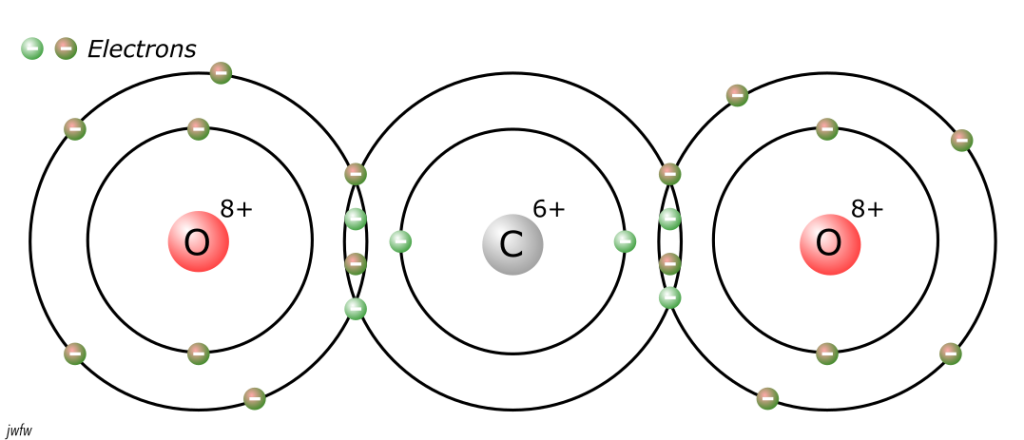
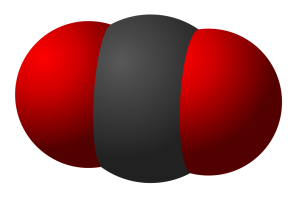

The heat we obtain from fossil fuels like coal, oil, and natural gas comes, to a large extent, from the formation of these double C=O bonds, so it’s worth exploring just how much energy this process releases. To do this, we need to make use of a concept called the mole (abbreviated mol), used by chemists.
A mole of any substance is its atomic or molecular weight, expressed in grams.
Thus a mole of carbon is 12 grams and a mole of water is 18 grams (because the molecular weight of water is 18). Thus a mole of any element contains the same number of atoms and a mole of any compound contains the same number of molecules. This number is known as Avogadro’s number or the Avogadro constant and is a huge number.
Avogadro’s number 6.022 x 1023: the number of atoms in 12 g of carbon-12
The advantage of using moles is that if we were to calculate the energy released by making one C=O bond it would be tiny (about 1.3 x 10-18 J). By measuring a mole of bonds we get at least a reasonably manageable number: 799000 J/mol or 799 kJ/mol.
The table shows this amount, together with the energy associated with a number of other types of bonds that are common in carbon compounds found in the Biosphere.
| Bond | Energy (kJ/mol) |
| C=O * | 799 (2 x 399) |
| O-H | 467 |
| C-H | 413 |
| C-C | 347 |
| C-O | 358 |
| H-H | 432 |
| O=O | 495 (2 x 247) |
| C=C | 614 (2 x 307) |
| * as found in CO2 |
Oxidized forms of carbon
A substance, like carbon dioxide, in which carbon shares all its outer electrons with oxygen can be described as an oxidized form of carbon. There are only four commonly occurring oxidized forms of carbon in the Earth system and they are easily converted, one into another. We have met most of them already.
Carbon dioxide CO2
Carbon dioxide reacts with water to form carbonic acid
CO2 + H2O => H2CO3 Carbonic acid
Carbonic acid loses a hydrogen ion H+ to make…
Bicarbonate ions HCO3–
Bicarbonate ions lose another hydrogen ion H+ to make…
Carbonate ions CO32-
 |
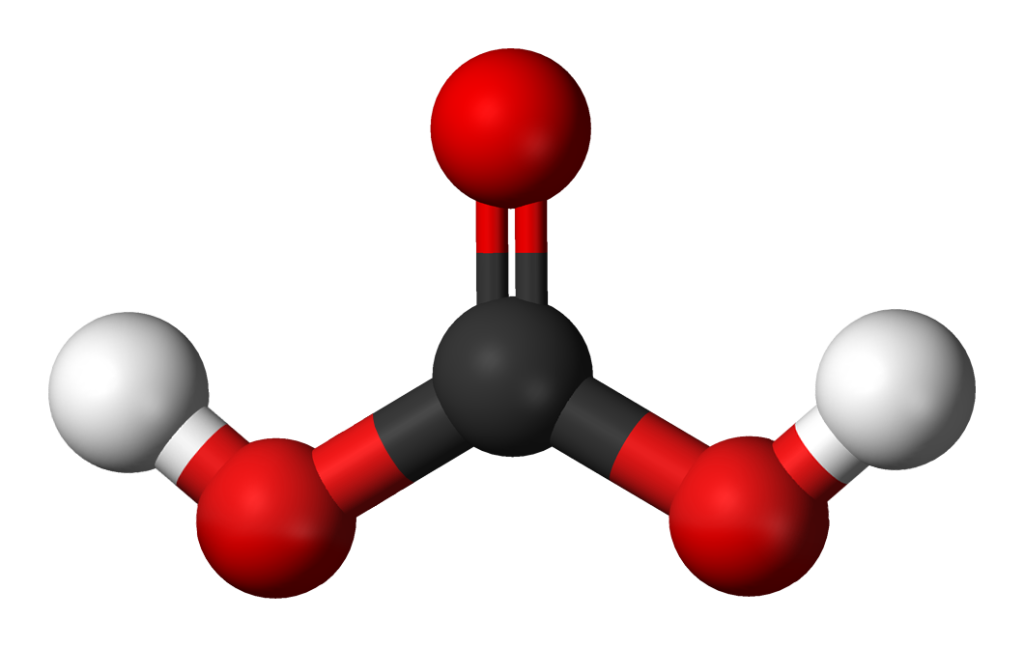 |
| Carbon dioxide. By Jynto (talk) – This image was created with Discovery Studio Visualizer., CC0, https://commons.wikimedia.org/w/ | Carbonic acid. By Jynto and Ben Mills – Derived from File:Urea-3D-balls.png., Public Domain, https://commons.wikimedia.org/w/ |
 |
 |
| Bicarbonate ion. By Ben Mills and Jynto – Recolour of File:Nitric-acid-3D-balls-B.png., Public Domain, https://commons.wikimedia.org/w/index.php?curid=8391122 | Carbonate ion. By Benjah-bmm27 – Own work, Public Domain, https://commons.wikimedia.org/w/index.php?curid=1989686 |
Reduced forms of carbon
The rest of the carbon in the Biosphere contains carbon that does not share all its outer electrons with oxygen. We say this is fixed or reduced carbon. Typically, carbon is bonded to other carbon atoms and to hydrogen atoms, in organic carbon compounds. In organic molecules carbon is also commonly bonded to nitrogen (N), phosphorus (P), and to OH (hydroxyl) groups. The C-C bonds are particularly important, because they allow reduced carbon compounds to form almost infinitely long chains with repeating elements, known as polymers. Examples we shall meet include proteins and nucleic acids.
Smaller molecules with short chains of carbon atoms are important for metabolism. These include carbohydrates, which have formulas that can be written as combinations of carbon with water. An example is the sugar glucose, shown in the diagram.
C6H12O6

Reduced carbon compounds can typically be made to burn in oxygen producing CO2. These oxidation reactions work because the energy needed to break bonds of carbon with hydrogen or other carbon atoms is less than the energy supplied by making C=O bonds.
Energy release during oxidation

To see how this works, let’s look at the oxidation of one of the simplest organic carbon compounds, methane, the principal component of natural gas.
CH4 + 2O2 => CO2 + 2H2O
Methane + oxygen => carbon dioxide + water
To start with, we need to break four C-H bonds and two O=O bonds. We usually do this using a match or a spark to provide the initial energy.
The amounts of energy are:
C-H bonds. 4 x 413 = 1652 kJ/mol
O=O bonds. 2 x 495 = 990 kJ/mol[1]
Total. 2642 kJ/mol
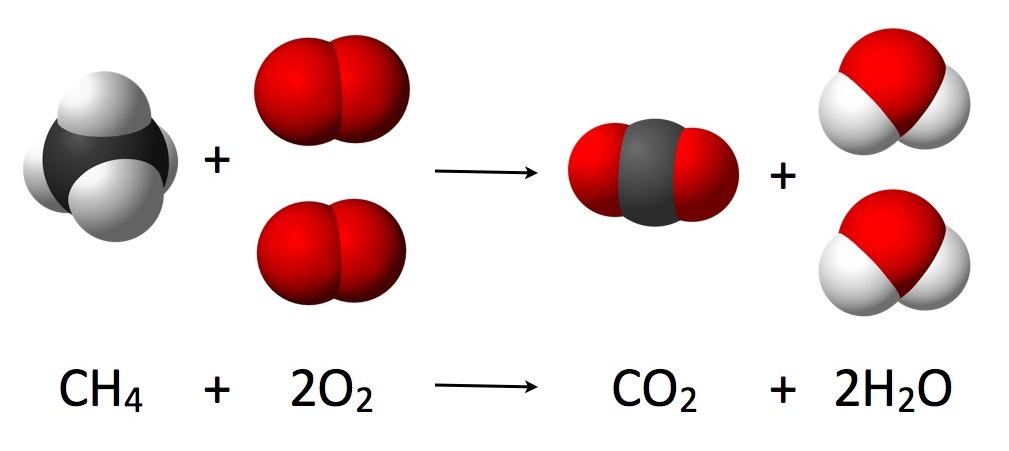
Then, we can see how much energy we get back making carbon dioxide and water
C=O bonds. 2 x 799 = 1598 kJ/mol
H–O bonds. 4 x 467 = 1868 kJ/mol[2]
Total 3466 kJ/mol
Net release of energy on combustion of methane: 3644 – 2642 = 824 kJ/mol
So, much more energy comes out of this reaction that we put in to break the bonds. Once the reaction is started, the output of energy is sufficient to keep breaking bonds in methane and oxygen until one or the other is used up, when the reaction stops.
The reaction converts reduced, or organic carbon, to oxidized carbon. To reverse the reaction and reduce the carbon in carbon dioxide back to methane we would have to put in the same amount of energy that we get out when methane is oxidized. Any process that forms organic compounds from carbon dioxide or its oxidized relatives requires input of energy.
Photosynthesis and respiration
Photosynthesis
One major process is responsible for the fixation of most of the organic (i.e. reduced) carbon in the Biosphere, and that process is photosynthesis. During photosynthesis, plants use solar energy to break the bonds in carbon dioxide and react it with water to produce organic compounds.
Carbon dioxide + water => carbohydrate + oxygen
6CO2 + 6H2O => C6H12O6 + 6O2
The formula represents a common carbohydrate, the sugar glucose. In reality, photosynthesis ultimately produces many other kinds of organic compounds too.

In the above reaction, C=O and C-H bonds have to be broken, which requires a great deal of energy, as we have seen when we looked at methane. Some of that energy is recovered in re-joining the atoms to make carbohydrate and oxygen, but the overall reaction requires a net input of energy of 2872 kJ per mole[3] of glucose produced.
To trap this energy, most plants contain a green organic compound chlorophyll, that contains an atom of magnesium surrounded by four nitrogen atoms, a group that is effective in absorbing light. The formula and structure of chlorophyll are shown below:
C55H70O6N4Mg (Don’t try to memorize this formula!)

Photosynthesis takes place in the cells of a group of single-celled organisms called cyanobacteria (formerly known as blue-green algae), which were very important parts of the Biosphere early in Earth history. Other groups of plants, which appeared later, have cells that contain chloroplasts that function like cyanobacteria (and may in fact have evolved from cyanobacteria that were engulfed by other single-celled organisms. These chloroplasts contain chlorophyll that traps light energy. The energy is then transferred to the carbohydrate-building parts by phosphorus-bearing molecules ADP and ATP (adenosine diphosphate and triphosphate).
Chemosynthesis
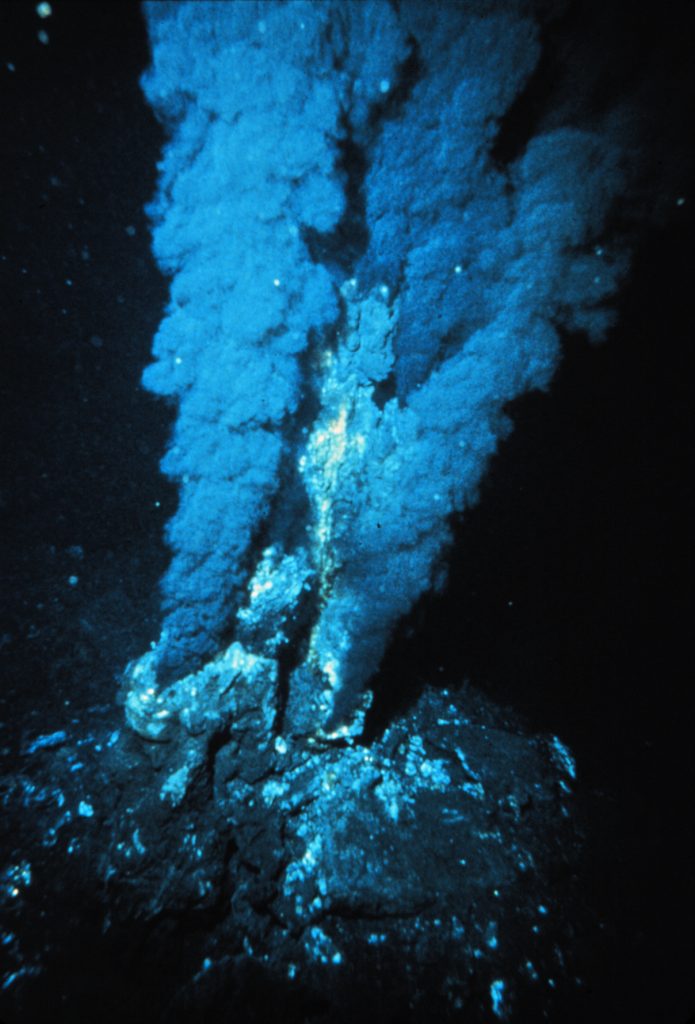
Although most of the energy input to the Biosphere is captured via photosynthesis, a small amount comes from other sources. Chemosynthesis involves reactive chemicals emitted from (mostly) submarine hot springs. For example, most submarine hot springs emit the gas hydrogen sulfide H2S. For humans, this is a poisonous gas which has a bad-eggs smell in low concentrations. However for some organisms it’s an essential supply of energy because it can be used to reduce carbon dioxide, instead of light.
Here’s a typical reaction:
12H2S + 6CO2 → C6H12O6 + 6H2O + 12S
Hydrogen Sulfide + Carbon dioxide → Carbohydrate + Water + Sulfur
Reactions like this are known as chemosynthesis reactions. They probably were important in the very earliest forms of life, before the appearance of chlorophyll. They are still important on the deep ocean floor around submarine hot springs, where they support unique chemical-powered ecosystems that have only recently been explored.
![]()
Respiration

Part of the organic carbon captured by photosynthesis goes to building body structure. The rest is recombined with oxygen to release the energy so that it can be used to fuel their living processes. The process of oxidation and energy release is known as respiration — a term that originally referred to breathing, but now includes all the processes organisms use to obtain energy by oxidation of fuels such as carbohydrate.
The energy exchanges in respiration are the reverse of those in photosynthesis. As in the case of photosynthesis they can be approximately calculated by adding and subtracting bond energies.
For example, a typical respiration reaction is the oxidation of glucose to produce carbon dioxide and water.
C6H12O6 + 6O2 => 6CO2 + 6H2O
Carbohydrate + oxygen => carbon dioxide + water
Net energy output (-ΔH) = 2872 kJ/mol
In actual cells, not all of this energy is released as heat. Some of it is transferred to phosphorus-bearing molecules, like ADP and ATP (adenosine diphosphate and triphosphate), which are used as fuel by other processes that require energy within cells.
Autotrophs and heterotrophs

Organisms that obtain energy by photosynthesis or chemosynthesis are called “autotrophs” (from Greek words for “self” and “feeding”). Autotrophs include cyanobacteria and green plants generally, together with organisms, including many archaea, that obtain their energy from chemosynthesis. Overall in the Biosphere, autotrophs use about half of the carbon they “fix” to provide energy through respiration. The other half is used to make organic molecules that build their body structure.
The energy in these body structures may be captured by other organisms through feeding, or through decay and decomposition processes. Organisms that obtain their energy this way, by consuming others’ bodies, are called heterotrophs (“other feeding”). Fungi and all animals, including of course humans, are heterotrophic organisms.
The carbon cycle
We are now in a position to understand a major cycle that operates through all the systems of the Earth, the carbon cycle. Clearly, the carbon cycle is closely linked to the energy cycle, as energy is largely transported through the Biosphere as reduced, or organic carbon. The carbon cycle is also closely connected with the water cycle, as large amounts of oxidized carbon are dissolved in the oceans as bicarbonate ions.
In looking at the carbon cycle, we will first distinguish oxidized, or inorganic carbon, from reduced or organic carbon.
Oxidized carbon includes all forms in which all four outer electrons are involved in bonding with oxygen:
- Carbon dioxide
- Carbonic acid
- Bicarbonate ions
- Carbonate ions
Reduced carbon includes all forms in which carbon is connected by some of its bonds to atoms other than oxygen:
- Carbohydrates
- Other organic polymers such as protein, DNA etc.
- Buried organic remains in soil and sediment
- Fossil fuels: Natural gas, oil, coal
- Graphite and Diamonds
The first four of the above categories of reduced carbon, in which carbon atoms are linked both to each other and to hydrogen, are known as organic carbon. Graphite and diamonds contain carbon atoms that are entirely linked to each other. These forms of carbon, though reduced, are regarded as inorganic carbon because only carbon involved in their structure.
Where is the carbon?
In looking at the Earth’s principal carbon reservoir, our unit will be the gigatonne or Gt. One gigatonne is a billion tonnes or 1012 kg, or 1015 g.[4]
Note that these amounts represent the amount of pure carbon in each reservoir. They not the amounts of carbon dioxide, or carbohydrate etc., because those molecules contain other atoms like oxygen and hydrogen. When we say that the atmosphere contains 885 Gt of oxidized carbon, we are just weighing the carbon atoms, and not the oxygen atoms in each carbon dioxide molecule.

Atmospheric carbon
We have already looked at carbon in the atmosphere and established that (as of 2022) the atmosphere contains about 415 ppm of oxidized carbon in the form of carbon dioxide. If we do the calculations, using the total mass of the atmosphere (estimated from its pressure) and the molecular weight of carbon dioxide (44) we find that it corresponds to about 885 Gt of carbon.
To convert atmospheric carbon dioxide in ppm to total atmospheric carbon in Gt, multiply by 2.13
That amount of atmospheric carbon dioxide fluctuates from season to season and year to year. A measurement site in Hawaii, far from large local sources of carbon dioxide, provides daily data and graphs at https://gml.noaa.gov/ccgg/trends/


What are the reasons for these trends?
The “sawtooth” pattern in the curve is due to the balance of photosynthesis and respiration in the Biosphere. There is more land area in the temperate latitudes of the northern hemisphere, and as a result there are more trees. Forests, as we shall see when we look at biomes, are one of the most productive environments on the surface of the Earth. In the northern hemisphere summer, from May until October, photosynthesis is most active. Atmospheric carbon dioxide is drawn down during these months, typically by about 5 ppm, as organic carbon is fixed in the bodies of trees and other plants. In the northern winter, from November to April, part of this organic carbon is released by respiration as photosynthesis slows down and plants burn their stored fuel to provide energy. Of course, the northern winter is also the southern summer, but the southern forests are smaller, so their increased photosynthesis is not enough to offset the slowdown in the northern hemisphere.
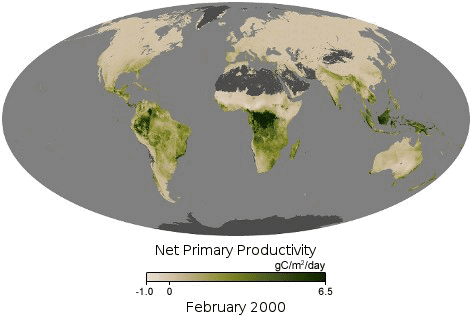
The steady upward trend has a different cause. It’s pretty clear that atmospheric carbon dioxide stayed reasonably constant around 280 ppm from the end of the most recent glaciation, at about 10 ka, until around 1750 CE, when humans first started burning large amounts of coal for industrial and domestic heat-generation. Oil and natural gas became major additional sources during the 20th century. We know these values principally from measurements made from air bubbles trapped in ice in the Crysophere. Direct measurements at the observatory in Hawaii began in 1958, when the concentration was 315 ppm, and the increase has been closely monitored since then.
Interestingly, we can also roughly calculate the amount of carbon that has been oxidized by humans, by analyzing economic reports from coal mines, and oil and gas wells. The total turns out to be about twice as large as the increase in atmospheric carbon. Where did the rest of it go? The answer lies in the hydrosphere, which dissolves about half of the excess carbon dioxide and converts it to bicarbonate ions, providing an element of negative feedback. However, this has consequences for the hydrosphere too, as it increases the acidity of the oceans.
There is also a reservoir of reduced carbon in the atmosphere, in the form of methane CH4. The total amount of methane in the atmosphere, equivalent to 3 Gt of carbon, is over a hundred times smaller than the amount of carbon dioxide, but it is a powerful greenhouse gas and so must be considered in the understanding of climate change.
Hydrosphere carbon
Like the atmosphere, the hydrosphere contains both oxidized and reduced carbon, and like the atmosphere, the oxidized carbon predominates.

Carbon dioxide dissolves in rain water to form carbonic acid H2CO3 and that carbonic acid immediately dissociates into a hydrogen H+ ion and a bicarbonate HCO3– ion, so rain that falls on the oceans delivers oxidized carbon to the oceans. In addition, water that arrives in the oceans from rivers may contain additional bicarbonate ions if it has flowed over carbonate rocks such as limestone on its way.
The total mass of carbon contained in bicarbonate ions in the ocean is over 40 times larger than the amount in the atmosphere: about 37000 Gt. As more carbon dioxide is added to the atmosphere, some of it dissolves in the oceans, but because the oceans started with so much bicarbonate, the change is much harder to detect than the rising carbon dioxide in the atmosphere. The increase is manifested by an increase in acidity (fall in pH) due to the extra hydrogen ions, and has become detectable since around 1995.
There’s also reduced carbon in seawater, known as dissolved organic carbon. It probably mostly exists as carbohydrates and amino acids (building blocks of protein) in very low concentrations that are highest in the surface waters (photic zone) and decline with depth. The total amount is estimated at 770 Gt.
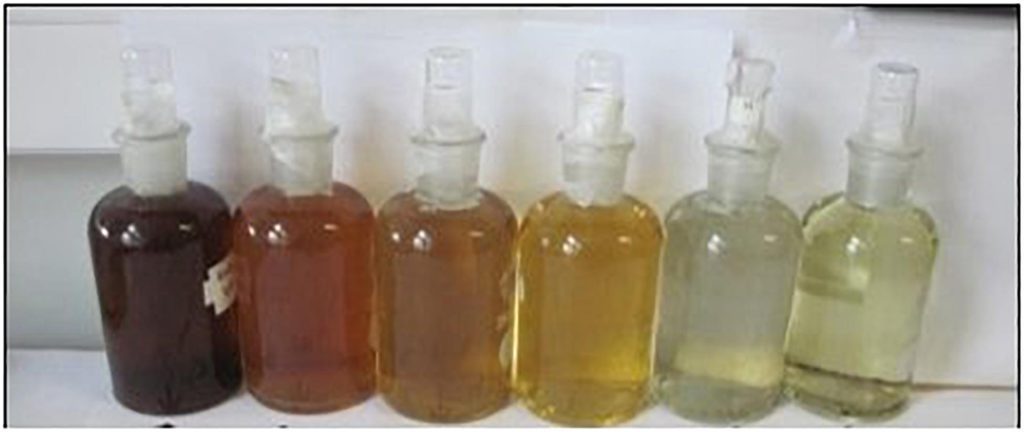
Biosphere carbon

Because the Biosphere is so varied, and difficult to sample uniformly, measuring its mass is extremely difficult. Estimates have huge associated uncertainties. The figures we give here are based on an open-source paper by Bar-On, Phillips and Milo, 2018. The biomass distribution on Earth. Proc. Natl. Acad. Sci. U.S.A. 115, 6506–6511. https://doi.org/10.1073/pnas.1711842115, together with estimates from the Wikipedia page on Biomass (ecology) https://en.wikipedia.org/wiki/Biomass_(ecology), downloaded in 2022, and from the 2022 report of the Intergovernmental Panel on Climate Change (IPCC). These numbers may be superseded by future research which may reduce some of the uncertainty. The numbers in this section are for living organisms. Dead animals, plants, and microbes end up in the Geosphere, if they are not respired by decay processes, and will be counted there.
![]()
All sources agree that the largest contributors to Earth’s biomass are land plants: 450 Gt or over 80% of the total mass of the Biosphere. Next on the list are microbes — bacteria and archaea, mainly — living in soils and other places within the Geosphere at around 80 Gt (although estimates are quite varied). What about land animals? They account for a relatively tiny amount of biomass carbon, around 0.4 Gt. Humans account for a surprisingly large proportion of this: 0.06 Gt or 60 Mt. Humans are exceeded only by cattle (mostly farmed by humans), which may account for 0.1 Gt. The oceans, although large, are rather sparsely populated; their total animal and plant populations only account for about 6 Gt, in most estimates. The most productive species is the Antarctic krill, which accounts for 0.05 Gt, making it the third most massive species after cattle and humans.


![]() The Biosphere also contains oxidized carbon in the form of calcium carbonate. On land, this is vanishingly small – eggshells, and small amounts in green vegetables like broccoli. In the oceans there is more: two large groups of plankton have calcium carbonate shells (Forminifera — single-celled animals — and Coccolithophores — single-celled photosynthesizers). There are also mollusc shells and other animal and plant skeletons including corals, many of which get transferred to the Geosphere as sediment. The total is likely to be less than the organic carbon biomass – a few gigatonnes at most, though hard estimates are difficult to find.
The Biosphere also contains oxidized carbon in the form of calcium carbonate. On land, this is vanishingly small – eggshells, and small amounts in green vegetables like broccoli. In the oceans there is more: two large groups of plankton have calcium carbonate shells (Forminifera — single-celled animals — and Coccolithophores — single-celled photosynthesizers). There are also mollusc shells and other animal and plant skeletons including corals, many of which get transferred to the Geosphere as sediment. The total is likely to be less than the organic carbon biomass – a few gigatonnes at most, though hard estimates are difficult to find.
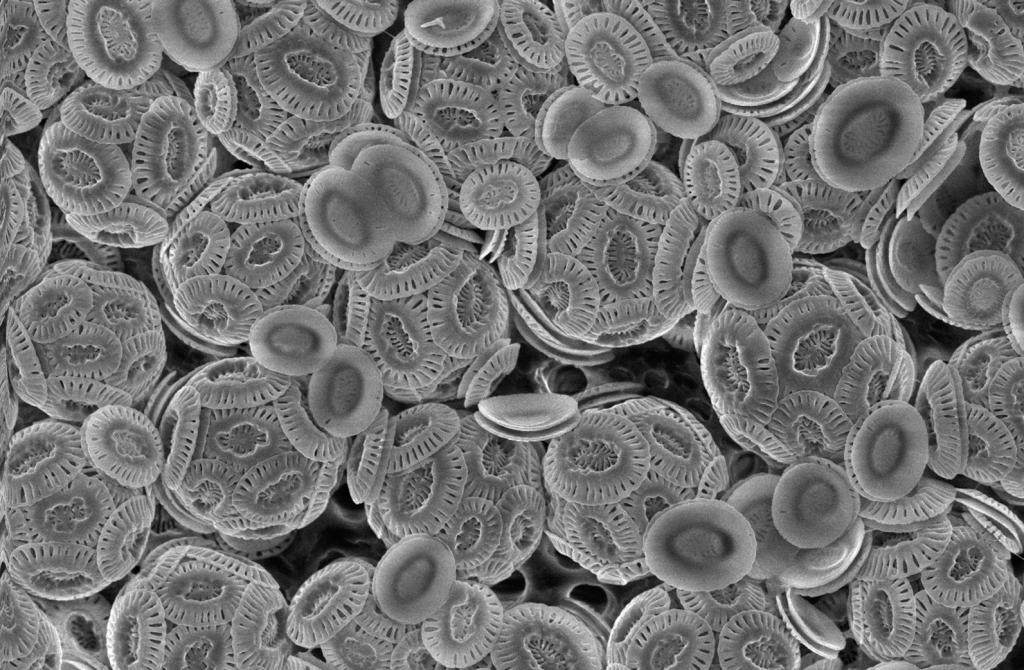
![]()
Geosphere carbon
A huge amount of carbon resides in the Geosphere. Measuring the actual amounts is challenging, both because its distribution is very heterogeneous – there are regions with very high concentrations and others where it is extremely low — and because the deeper we go in the Geosphere, the fewer are the samples that are available. Drilling deeper than a few kilometres is very expensive, and samples that have been brought up from depth (for example in volcanic eruptions) may have had their carbon contents changed in the process.

One large reservoir that is reasonably quantifiable is the oxidized carbon in carbonate rocks. These are mostly calcium carbonate — limestone and marble — but also include magnesium-bearing carbonates. Most were deposited as sedimentary rocks from sea-water, overwhelmingly through the action of the Biosphere. Many organisms, including corals, together with molluscs, crustaceans, and many other groups, build skeletons of calcium carbonate. In addition, a large group of prokaryotes, the cyanobacteria, deposit calcium carbonate directly on the sea floor. Before the evolution of multicellular organisms, the cyanobacteria were responsible for most calcium carbonate deposition. Carbonate rocks in the Earth’s crust are estimated to contain about 60,000,000 Gt of oxidized carbon.
The rest of the carbon in the crust is reduced. There are estimated to be about 1500 Gt of organic carbon in soils: this is the dead remains of unicellular and multicellular organisms, and is in addition to the living soil microbes listed above under the Biosphere.
There’s also a vast amount of organic matter in sedimentary rocks of the Earth’s crust. Most of this material was originally deposited along with fine-grained sediment in mud, in floodplains, lakes, and on the sea floor. The majority is therefore found in fine-grained sedimentary rock called mudstone (the term ‘shale’ is often used for these: shale refers to mudstone that splits easily into thin fragments, actually the most common type of mudstone). The total amount may be as much as 100,000,000 Gt.
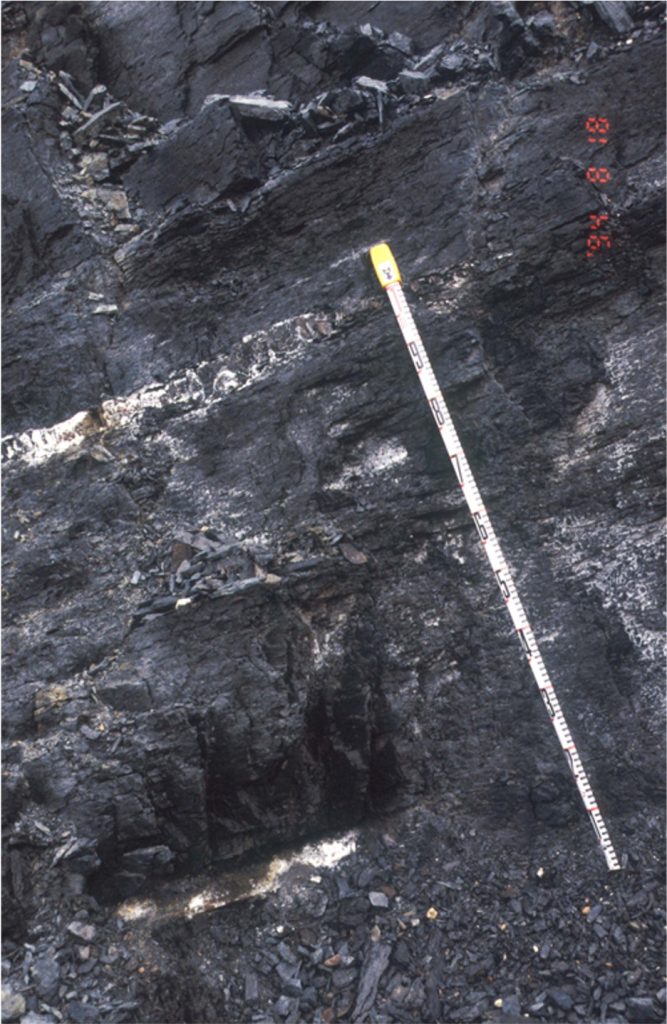
In places, the concentration of organic carbon in the Geosphere is sufficient for material to burn in air. Such materials are known as fossil fuels. Three major sources of fossil fuel are important to humans. First, the concentrated remains of land plants that form a type of soil called peat which may, on burial in the Geosphere, become the solid rock coal. Second, buried organic remains (typically marine microbes) may also produce liquid organic compounds that fill the pore spaces in sedimentary rocks: this is oil. Finally buried organic material may give off methane and other gases that accumulate in pore spaces as natural gas. The amount of Geosphere carbon that is counted as fossil fuel is somewhat dependent on technology. For example, developments of horizontal drilling and hydraulic fracturing have enabled production of oil and gas from rocks that would previously not have been counted in the total of fossil fuels. The figure of 18,635 Gt of carbon in fossil fuels is therefore approximate, and subject to change. This figure is for total estimated resources. Known reserves that can be exploited under current economic conditions are estimated at 928 Gt.[5]
![]()

The most uncertain figures of all are the carbon contained in the Earth’s mantle and core. Carbon certainly occurs in both oxidized and reduced forms in the mantle. The oxidized form is present as carbonates, probably mostly magnesium carbonate, as magnesium is very abundant in the mantle. The reduced form occurs predominantly as diamond, a form of pure carbon that forms at very high pressures. The total mantle carbon content, and the proportion of reduced to oxidized carbon are both very uncertain. An estimate of mantle carbon is 200,000,000 Gt.
We have no direct access to the Earth’s core and estimates of its carbon content vary. Typical iron meteorites contain about 0.04% by weight of carbon, though this is very variable, but a recent estimate based on chemical evidence suggests values up to 0.2%. Although these numbers are small, the core is very dense, so they represent amounts of carbon in the range from 800,000,000 up to 4,000,000,000 Gt, possibly accounting for 80 to 90% of the Earth’s total carbon. Because the core consists mainly of very dense liquid metal, and the mantle consists mainly of less dense solid silicate minerals, it’s very difficult for carbon to escape from the core, so carbon in the core plays little role in the carbon cycle.
Carbon fluxes

Carbon fluxes (rates of movement) between these reservoirs are shown by arrows in the diagram. The Biosphere (excluding human intervention) emits and captures about 112 Gt per year of carbon dioxide to and from the atmosphere. Thus the residence time of carbon dioxide in the atmosphere is quite short (about 6 years). However, about 54 Gt is transferred annually between the Atmosphere and the Hydrosphere, forming bicarbonate ions, and the residence time of carbon in the oceans is much longer (about 350 years). Rates of transfer into the Geosphere are hard to calculate but it is estimated that 0.2 Gt of carbon is deposited as sediment into the Geosphere annually. A similar amount returns to the atmosphere and hydrosphere through volcanic activity and erosion, in the natural course of events, known as the slow carbon cycle. Residence times of carbon in the Geosphere are measured in millions or billions of years. However, the concept of residence time only really applies to reservoirs that are in a steady state. Humans have intervened dramatically in this part of the carbon cycle, and are removing beetween 9 and 10 Gt of carbon annually from the Geosphere as fossil fuel and for the manufacture of cement. This carbon is released into the atmosphere and thence into the oceans, accounting for trends in atmospheric carbon dioxide and oceanic acidity that are major environmental challenges for humanity.
- When we write “per mole” here we mean “per mole of methane”. Because there are two molecules of oxygen going in to the reaction and two moles of water coming out, the energies would be halved if we calculated them per mole of oxygen or water. ↵
- When we write “per mole” here we mean “per mole of carbon dioxide”. Because there are two molecules of oxygen going in to the reaction and two moles of water coming out, the energies would be halved if we calculated them per mole of oxygen or water. ↵
- If you add up the standard bond energies from the table higher in this section, you will get a slightly different answer, depending on which of several polymorphs of glucose you use. In complex molecules the strength of each bond is dependent on the adjacent parts of the structure, so the energies of formation cannot be precisely determined by adding the individual bond energies. ↵
- Some reports therefore show carbon amounts in Petagrams (Pg) where 1 Pg is exactly the same amount as 1 Gt. ↵
- Estimates from Intergovernmental Panel on Climate Change (2021) Climate Change 2021. The Physical Science Basis. ↵
Isotopes of an element are atoms that have the same atomic number but different atomic mass, because of different numbers of neutrons in the nucleus
A stable isotope of carbon with seven neutrons that makes up a minority of natural carbon atoms.
Described bonding of atoms by the sharing of electrons
The number of atoms or molecules in a mole of a substance.6.022 x 1023
Oxidised or oxidized: The state of an atom that has lost one or more electrons during a chemical reaction; named because oxygen is the most common remover of electrons.
A gas in which each molecule combines one atom of carbon with two of oxygen; formula: CO2
A weak acid formed in solution when carbon dioxide dissolves in water: formula H2CO3;.
A negatively charged ion with the formula HCO3-, or a compound containing such ions
Nitrogen is described as fixed when it has been converted from its atmospheric form into a form more usable by organisms
The state of an atom when an additional electron is added during a reaction; opposite of oxidation
Any reduced carbon compound containing carbon–hydrogen bonds (or, rarely carbon–halogen bonds); elemental forms of carbon (with only carbon–carbon bonds) are regarded as inorganic.
Molecules consisting of chains of amino acids linked by peptide bonds, that perform innumerable tasks within and outside cells
Long, chain-like molecules (polymers) composed of linked units called nucleotides. Two major kinds of nucleic acids exist: DNA and RNA.
Covalently-bonded compounds of carbon, hydrogen, and oxygen, in which hydrogen and oxygen are present in the same proportions as in water
The transformation of atmospheric nitrogen into a form more usable by organisms.
An organic compound responsible for the absorption of light during photosynthesis.
Single-celled prokaryotes capable of photosynthesis and the release of oxygen. Cyanobacteria were responsible for the original oxygenation of the Earth’s atmosphere.
Organelles within plant cells that contain chlorophyll, and are responsible for photosynthesis in plants and photosynthetic microbes; chloroplasts are descended from free-living cyanobacteria.
A reduced form of sulfur that is emitted from hydrothermal vents where it provides a source of energy for chemosynthetic autotrophs in the absence of sunlight and oxygen.
A form of autotrophic metabolism where an organism obtains energy from chemical reactions without the assistance of sunlight
The oxidation of reduced (organic) carbon compounds by an organism to yield energy, carbon dioxide and water
Describes carbon compounds that lack carbon–hydrogen bonds.
A billion tonnes, equivalent to 1012 kilograms; sometimes called a petagram.
A system containing all Earth's ice
A cycle in which the products of a process act as inputs inhibiting the same process, reducing the effects of the process.
A gaseous compound of carbon and hydrogen CH4. Methane is the principal component of natural gas. In the Earth's atmosphere it acts as a greenhouse gas.
Carbon-rich substances found in the geosphere and formed from the remains of past-living organisms. Fossil fuels contain sufficient concentration of reduced carbon to produce usable heat when burnt in air.
The rate of flow into or out of a reservoir in a cycle

